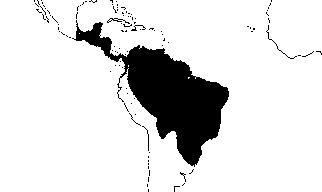| Name: Spectacled Owl |
| Scientific name: Pulsatrix perspicillata |
| Range: Central and Southern America |
| Habitat: Tropical rainforest, gallery forest |
| Status: Not endangered, but increasingly threatened by habitat destruction |
| Diet in the wild: Frogs, birds, bats, small mammals, insects and crustaceans |
| Diet in the zoo: Rodents |
| Life Span: Up to 25 years |
| Location at the Zoo: Bird Row; below Raptor Canyon |

|
| |
Physical description:
Average Adult Size
|
Special anatomical, physiological
or behavioral adaptations:
|
Comments
about the Spectacled Owl of the Fort Worth Zoo.
There are now two Spectacled Owls at the Fort Worth Zoo. Unfortunally, being nocturnal they are not out often. |
Sources and links
|
| Elise Manning -manning_e@juno.com Bryan Stevenson - bbs911@juno.com |